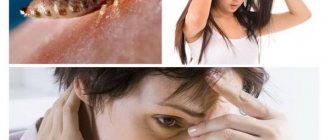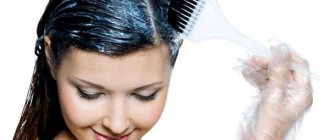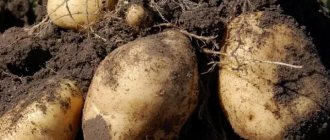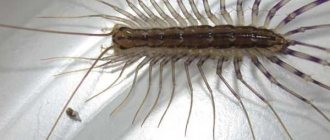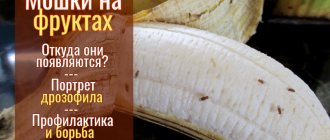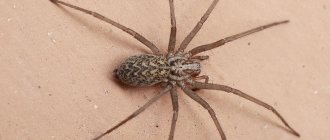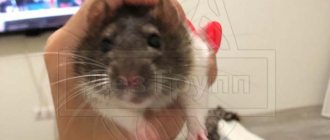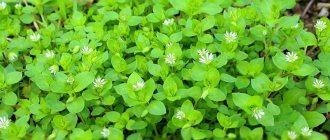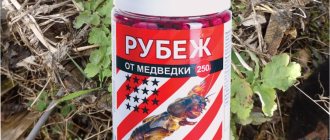Pediculosis in children: problems and concerns of parents
Kerosene, dust soap, hellebore water, fine comb or razor: among the older generation, these words are certainly associated with lice.
Pediatricians refer to head lice infestations as “pediculosis.” Although this is a completely ordinary parasitic disease caused by small insects that live on the scalp and suck blood, it is precisely this that causes a whole storm of negative emotions in parents - from anger and irritation to burning shame. In addition, the most ridiculous and funny myths are associated with this disease.
Lice: from time immemorial
Lice has accompanied people since the beginning of time. These parasitic insects are perfectly adapted to live in the hair or on the body of people.
Many sacred ancestral rituals are actually nothing more than a way to get rid of lice and prevent their recurrence.
Thus, the ancient Egyptian priests and kings, the pharaohs of Babylon and Assyria had their heads shaved so that “not a single louse would cling to the servants of the gods.”
Then lice was an indispensable companion to various wars, the life of nomadic peoples and tribes who had serious problems with hot water, soap and basic hygiene. Prisons, hard labor, overcrowding and unsanitary conditions are favorable conditions for the development of lice. When people live in cramped conditions and do not have the opportunity to properly wash, shower and tidy their hair, the appearance of various parasites is not surprising.
Why is the appearance of lice explained by nervous soil?
There is a sign that is equally characteristic of stress and head lice. It's an itch. With lice, the scalp itches unbearably. People also often scratch their heads when they are nervous. Therefore, an explanation emerged as to whether lice can appear from nervous stress. People believed that first they scratched their heads, and then lice appeared because of this. If this happened, it was a coincidence. Or the person actually caught lice, began to itch, became constantly nervous because of this, and eventually brought himself to a state of stress.
Causes of pediculosis
You can find out how the infection occurred by looking at the type of lice. Lice on the head appear from household contact with a carrier (transport, shared comb).
Unlike head lice, pubic lice are transmitted through sexual contact. The place of their influence is the pubic area.
You can become infected with body louse by wearing someone else's clothes or using someone else's bed linen (on a train, for example).
Parasites can cause serious discomfort (regardless of their type). Self-medication for infection is possible, but not recommended. It is better if a competent dermatologist examines the affected areas and subsequent therapy.
Symptoms of infection
Pediculosis can be detected at an early stage by the following main signs:
- itching It gets worse after washing your hair, in the evening, during sleep.
- Insect eggs (nits) are present.
- Feeling of crawling.
- Rashes in various manifestations (ulcers, papules, minor inflammations).
- Presence of excrement (like small black dots).
- Hair gets tangled and quickly gets dirty.
If you are unable to resolve the problem on your own, you should consult a dermatologist.
The first signs of lice on the head
You can suspect the presence of lice on your head based on the first signs.
In addition to itching, these include:
- deterioration of sleep.
- Irritability.
- Swelling of the lymph nodes.
To make sure you don't have parasites, it's worth doing a thorough inspection. A magnifying glass and flashlight will help you distinguish dandruff from nits.
Important: if there are too many parasites, death cannot be ruled out.
This is because lice cause both physical and psychological discomfort.
Itching
Symptoms of head lice may not appear immediately. The main sign of infection is itching. The discomfort is caused by a special enzyme that lice inject under the human skin during a bite.
It prevents the rapid clotting of blood, resulting in red blood dots remaining at the puncture site.
Please note: parasites can occur even in a small child. Since the baby, due to his age, will not be able to name the reason, he will cry constantly.
Itching of the skin bothers both day and night. If you feel discomfort during sleep, and washing your hair does not bring relief, you should examine your head for lice.
Bite sites
Lice bites are also signs of lice.
Most often, insects bite in places such as:
- temple area.
- The area behind the ears.
- The back of the head.
Spots of gray-blue shades may appear here. They are not dangerous, but clearly indicate a problem.
A red spot remains at the site of the bite, in the center of which a puncture can be seen. If the scale of infection is large, the spots merge, forming local redness. Scratching bites leads to the formation of wounds and crusts.
Tangles, hair gluing
One of the sure symptoms of the presence of lice on the head is the formation of tangles. Hair begins to stick together if the parasite carrier does not have the opportunity to wash his hair regularly (vagrancy, long expedition).
The eggs are attached to the hair by a special adhesive substance secreted by female lice. If an insect holds on to several hairs at once, they will all stick together.
With the complication of pediculosis, the number of glued tufts of hair increases, after which tangles begin to form.
Other symptoms
Symptoms of the disease worsen over time:
- nervousness.
- Pyoderma (purulent lesion of the skin).
- Sleep problems.
- Increase in temperature.
Sometimes these signs are complicated by the body’s allergic reaction to multiple bites. Knowing how to detect lice can help diagnose the disease in the early stages.
Signs of nits
The main sign of the presence of nits is parasites. When it gets on the hair, the female almost immediately lays eggs. After a week or a week and a half, new lice hatch from them, and the cocoons themselves remain hanging on the hair.
Visually, parasite eggs are very similar to dandruff. You can distinguish nits from skin flakes by their size and structure.
Body lice
Body lice (linen, clothes) reach 5 mm in length.
Habitats of the parasite:
- clothes and bed linen.
- Blankets.
- Mattresses.
The main symptom of this type of lice is itching of the skin under clothing. A person may feel like someone is running all over them. The reasons for its appearance are usually associated with the use of someone else's clothes and underwear.
Video
Where will the louse jump?
After how many days do lice become more numerous?
If at least one sexually mature individual appears on the head, it begins on the same day not only to bite, but also to lay eggs. One female lays an average of 4 eggs per day. That is, after 16–20 days there will be about 80 nits and lice on the head, including adults, ready for mating and further reproduction. Their number will increase exponentially. Among them there may be insects with increased fertility, laying up to ten eggs a day, so it is necessary to urgently begin the fight (for more details, see the article “How to get rid of lice forever.”
How to find out when lice appeared and where they got infected from? You need to carefully examine your head. If there are only nits on it, and no adults are visible, then no more than 5 days have passed. If insects about 3 mm in size are visible, it means that 2–3 weeks have already passed since the infection.
Complex wrestling
If you find lice in children, be sure to check the hair and heads of all other family members. Pediculosis is a highly contagious disease. One carrier will most likely affect the whole family. Everyone needs to get rid of lice. And even if you haven’t noticed any adults, it’s worth using a medicated shampoo as a preventive measure to kill nits and lice, which may remain invisible.
Lice emerge from the nits within 6–8 days. So within a week after treatment, you need to examine the heads in order to detect new individuals in time. To be on the safe side, you can repeat the treatment after 1 to 2 weeks.
Do not forget that lice can appear not only on the head, but also on the personal belongings of an infected person. They tenaciously hold on to the hair with their paws, but can simply fall onto clothes, bed, any surrounding objects, and then from there again move onto children and adults. To destroy parasites, it is advisable to treat the room where infected children or adults were. To do this, you can use different methods. In winter, you can freeze the room by turning off the heating and opening the windows for several hours. Insects die at temperatures below zero, but this is a very radical method. You can use chemical preparations with an acute pediculicidal effect, for example, Medilis-Malathion, Medilis-Permifen, Medilis-Super. They treat surfaces by wiping or spraying. Clothes can be soaked in a pediculicide solution and washed at temperatures above 40 degrees.
It is worth remembering that the comfortable temperature for lice is from 20 to 37 degrees. At levels lower and higher, they stop reproducing and living. They also constantly need food. Without blood, they can live up to 4 days, but more often they die after two days. Nits can fall into a state of suspended animation and spend up to a month in it, after which – when they find themselves in comfortable conditions – they continue their development. So if there are things affected by lice or nits that cannot be washed or treated in any other way, you can simply put them in sealed bags and leave them there for a month. During this time, the pests will die.
What lice and nits look like
The appearance of insects allows them to hide well in the hair.
Signs by which ectoparasites can be recognized:
- oblong body, similar to grains of rice.
- Small sizes (up to 5 mm).
- Color gray, brown. The shade changes when the louse becomes saturated.
Good fixation of lice on the hair is facilitated by the presence of paws with claws. The antennae are responsible for the sense of smell, but vision is completely absent.
Special needles help to carry out the puncture. To feed with blood, there is a proboscis that works like a pump.
The larvae mature in nits - special capsules with a lid. They are similar to dandruff, but are much smaller in size (up to 1 mm) and when pressed they produce a characteristic squeak.
Question answer
Many people faced with lice infection ask questions:
- Is it true that stress contributes to the appearance of bloodsuckers? During times of severe psychological distress, the composition of a person's internal secretions changes, leaving them more susceptible to lice infestation as the heavy odor of sweat attracts the parasites.
- Is it possible to get lice if you swim at a city beach? The pubic louse has the ability to survive in standing water for up to 2 days. Swimming in standing water carries some risk of infection.
- How to protect yourself from lice infestation? To reduce the risk of lice, you must adhere to the following recommendations: try not to visit places with large crowds of people where there are unsanitary conditions, do not use personal items of strangers, do not give your own, lead a healthy lifestyle, which contributes to the good functioning of the immune system.
An attack on a person by blood-sucking insects always causes a negative reaction. This is a natural reaction, because parasites obsessively affect the general mental state, causing significant discomfort and pain. In addition, getting rid of them is not always quick and painless.
Therefore, to prevent infection with lice, it is recommended to follow simple rules of personal hygiene.
Principle of reproduction
Once they get to a new host, the lice continue to live. First of all, this is nutrition and reproduction. To saturate, an adult consumes human blood every 4 hours; a nymph emerging from an egg consumes human blood at least once every 2 hours.
The amount of blood consumed is small, the bite is painless, but the parasite's saliva contains a toxin that provokes allergic irritation. Most often in a mild form: in the form of itching. The greater the number of bites, the more severe the symptoms become. You can find out what lice bites look like on our website.
Important point! The increase in the number of feeding individuals directly depends on the rate of reproduction of parasites. Once in a new environment, the female continues the reproductive cycle: laying eggs. Every day, 1 individual weaves up to 4 cocoons. Over a full life cycle (about 45 days), the female produces about 150 eggs.
Nits phase
As a result of mating of adults, all eggs present in the female are inseminated. A single fertilization starts the insect's lifelong reproductive process. Therefore, the entry of even a single female into a new territory will ensure a rapid increase in numbers.
The first laying of eggs occurs within a few hours after insemination by the male. The female is located on the hair near the root. It releases sticky mucus from the genitals, followed by an egg.
A viscous mass envelops the fruit, forming a kind of cocoon. The mucus quickly hardens in air, providing reliable fixation and protection.
The resulting formation is called a nit. This substance cannot be washed off with shampoo and is difficult to comb out with a comb. The nit shell is a reliable protection; even insecticides do not penetrate inside. After the larva emerges, the dry nit remains attached to the hair.
The nit phase lasts approximately 8 days. At this time, the formation of the insect organism occurs. A mature larva gnaws through the shell of the cocoon in search of food. The emerging larva (nymph) is hungry. To satisfy the need for food and activate growth, the individual begins to eat intensively.
Read here: what lice and nits look like, what they are, visual photos.
The duration of development of a louse in a nit depends on the environment. Under ideal conditions (air temperature +31, moderate humidity), the larva is able to emerge from the cocoon in 1 day. If the situation sharply worsens (temperature drops to +10 degrees), development will slow down, which will be approximately 10 days.
Complete death of the nit occurs only under very harsh conditions. If the host is exposed to frost for a long time at 20 degrees (from 2 hours), the larva dies inside the egg. Adults and nymphs can die at -10 degrees. Less pronounced subzero temperatures cause the embryo to stop development. This is due to the fact that at the base of the skin, where the nits are attached, it is always warmer due to the natural heating of the living human body.
High positive air temperatures also affect the development of the insect. At +40 degrees, adults stop breeding and feeding. In the temperature range of 40–50 degrees Celsius, insects die. Nits lose viability at temperatures of 50–60 degrees Celsius.
We recommend reading: at what temperature do lice and nits die.
Larval transformations
The nymph, unlike a fully formed individual, has a smaller body size and is not capable of reproduction. The appearance of the larvae and feeding method are similar to the adult representatives. This strategy is called incomplete conversion.
Gradually, the larva's body grows, but the protective chitinous shell remains the same (about 3 days after leaving the cocoon). To adjust the discrepancy, you have to remove the hard shell. The body of a naked nymph hardens under the influence of air. The grown larva takes on its previous appearance, differing only in the changed dimensions.
The molted nymph (1st generation) continues its previous life activity for 2 days. Then, re-molting occurs. The 2nd generation nymph appears. This creature spends 3 days preparing for adult life (the formation of genital organs occurs).
The last moult turns the insect into an adult louse (imago). Sexually mature parasites begin mating, starting a new development cycle.
Under favorable conditions, the full cycle of life formation from egg to adult takes place in 15–16 days. Lack of sufficient nutrition and worsening temperature conditions lead to an extension of development stages to 20–30 days.
Adult
The insect, which has turned into an imago, finds a partner within 2 days and mates. A day after fertilization, the female begins to lay eggs. 2–4 pieces daily. The louse attaches eggs to the roots of the hair. The location of the nits indicates the laying period.
During 30–40 days of existence, each imago produces 120–160 eggs. How many nits will be formed depends on the living conditions of the insect. Given this rate of reproduction, it becomes clear why lice begin to spread so quickly.
Parasitic activity, supported by comfortable living conditions, prevents the lice from losing food. The bloodsucker constantly has a power source. The parasite has no enemies: no energy is wasted on survival. A female only needs to mate once to reproduce throughout her life. These factors provide ideal conditions for population growth.
We recommend reading: How long do lice live outside the human head?
Interesting fact. An adult male has a short life. After passing through the development phase to a sexually mature insect, mating, the male individual parasitizes for about 7 days. Then, the death of the insect occurs.
What to do if head lice is confirmed
Having identified pediculosis, it is important not to delay treatment.
Therapy should be comprehensive, consisting of 2 stages:
- Mechanical impact (combing).
- Chemical exposure (use of drugs).
A fine-toothed comb is suitable for combing. The procedure is carried out for several days in a row until the parasites are completely removed.
The use of special drugs must be agreed with a specialist. If a small child is infected, aerosols are used for ease of treatment.
Please note: the dermatologist selects the product and dosage based on the clinical picture.
Self-medication can provoke allergic reactions to drugs. During therapy, it is important to remove the larvae, because they will later develop into adults.
